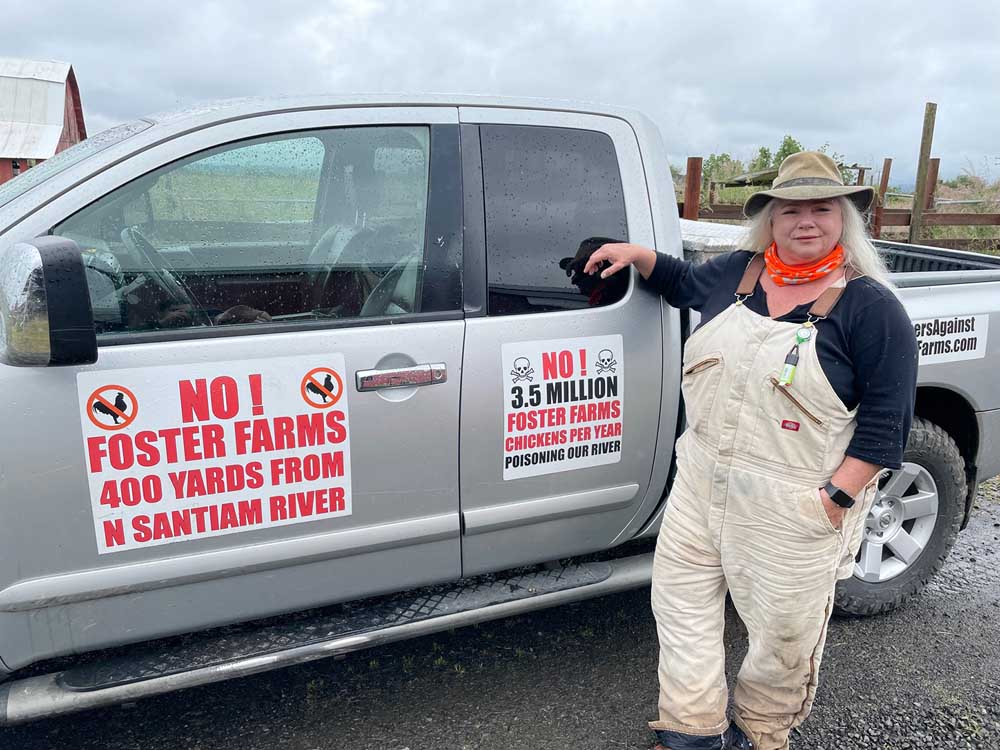Oregon county approves one-mile setback for large CAFOs
Published 4:00 pm Monday, December 18, 2023

- Christina Eastman, a member of the Farmers Against Foster Farms group, stands next to her pickup truck at her family’s farm near Scio, Ore.
ALBANY, Ore. — Officials in one Oregon county have approved new rules restricting where large-scale confined animal feeding operations, or CAFOs, can be built under a state law passed earlier this year.
The Linn County Board of Commissioners voted Dec. 12 to require that such CAFOs include a minimum one-mile setback from residential property lines.
The issue stems from concerns raised by a group of small-scale farmers and community members over three proposed chicken farms in rural Linn and Marion counties that would have raised millions of birds annually for the poultry company Foster Farms.
Opponents took their concerns to the state legislature, which passed Senate Bill 85 reforming how CAFOs are permitted.
SB 85 also limits the amount of groundwater large CAFOs can pump to 12,000 gallons per day, and grants counties the authority to impose setbacks between the farms and their neighbors to mitigate conflicts over traffic and odor.
Linn County became the first to adopt setbacks under SB 85. The county planning commission initially recommended a three-quarter mile buffer, but commissioners increased it to a minimum of one mile after further discussion.
“First and foremost, we are incredibly grateful to the county commissioners for listening to us and hearing us, and then taking swift action to protect our farms and our homes,” said Kendra Kimbirauskas, who runs a small farm near Scio.
Kimbirauskas is a member of the local group Farmers Against Foster Farms, which organized to oppose the three chicken CAFOs.
One of the farms, J-S Ranch, was already permitted by the state Department of Agriculture and Department of Environmental Quality before passage of SB 85. It is now being challenged in Linn County Circuit Court over potential surface water and groundwater pollution.
J-S Ranch calls for building 11 barns each measuring 39,120 square feet that will house six flocks of 580,000 broiler chickens per year near Scio, totaling 3.48 million birds.
Two other proposed chicken CAFOs — one near the small community of Jordan in Linn County and one between the cities of Aumsville and Stayton and Marion County — will apparently not go forward after each property was recently listed for sale.
Because its permits have already been issued, J-S Ranch is not be subject to Linn County’s one-mile setback. However, the lawsuit against ODA and DEQ seeks to overturn the state’s permit, arguing it does not adequately protect against potential water contamination.
If that happens, then the farm would need to get a new permit that complies with all regulations under SB 85, said Amy van Saun, a Portland-based attorney with the Center for Food Safety who is representing the plaintiffs in the case.
The plaintiffs include Farmers Against Foster Farms, Friends of Family Farmers, Willamette Riverkeeper and Christina Eastman, whose family farm is next to the J-S Ranch property.
“If the judge denies our claims and lets the permit stand, it would go on as already proposed,” van Saun said.
Bill Mattos, president of the Northwest Chicken Council, said the organization plans to review Linn County’s setback for CAFOs to ensure it complies with state land use laws.
“We’re concerned that the recent Linn County decision has the potential to not only impact poultry growers, but the rights of all farmers to use their land for agricultural purposes,” Mattos said in a statement. “Our growers face increasing challenges in finding available land to modernize their operations and meet the growing nutritional needs of our people.”
Mattos also defended the industry’s environmental record, and said that chicken farms have co-existed with their neighbors in Linn County for decades.
“As a state and as a community, we benefit in many ways from locally raised poultry, livestock and crops,” Mattos said.
Two sites for planned chicken farms up for sale
Poultry debate: Large chicken farms raise concerns in rural Oregon
Oregon livestock operation reforms approved five years after dairy debacle







